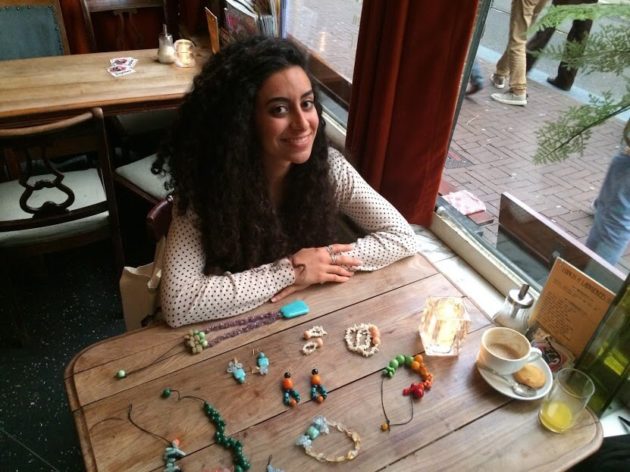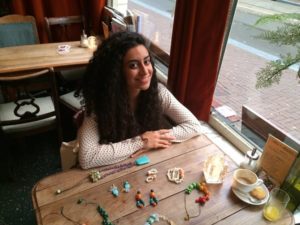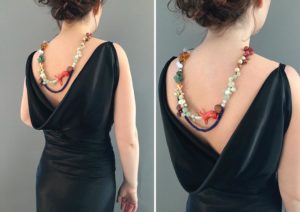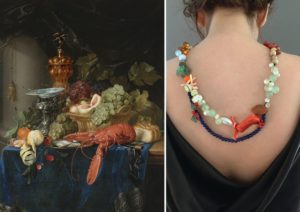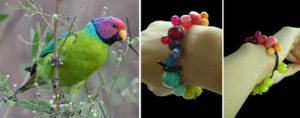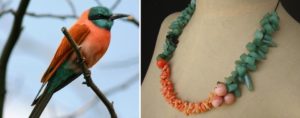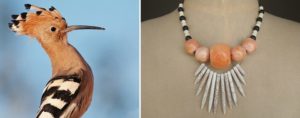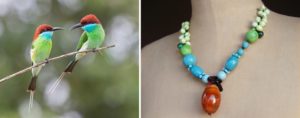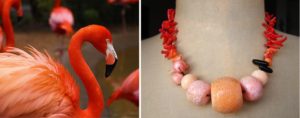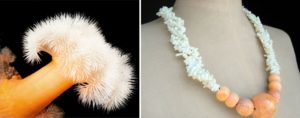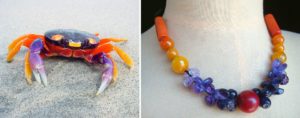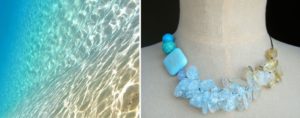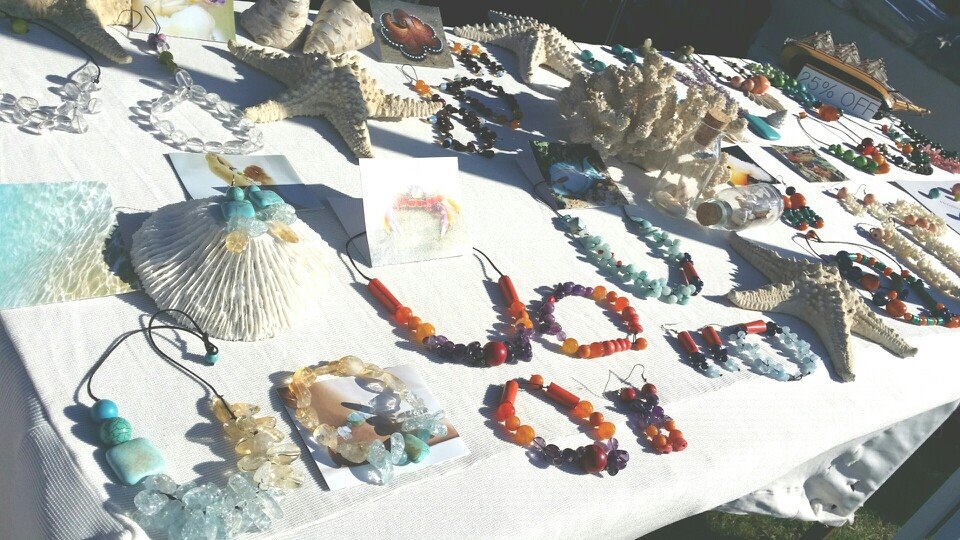Travelling can inspire you in many ways, especially if you were moving and travelling since you were a kid. Started her expat life at a young age, Nahla El-Gizawy truly is a global nomad. And she uses it in the best possible way – by making art of it. Founder of Analogie Jewelry, Nahla is looking for inspiration for her collections all around the world, in nature, under the sea or in a great diversity of world cultures.
Being a global nomad, my personality, values and skills are of a quite diverse mix. I have been travelling my whole life between the East and the West, and that has helped me see the bigger picture and adapt to various situations in a quick manner.
# How did you become an expat?
I was born in Egypt, and I have been on the go ever since. Starting with an international primary school in Rome, I had friends from all over the world. At such a young age it was extremely interesting to engage with children from different backgrounds. It broadened my vision of what cultures are made of, not just learning about it from books. I had classmates from Sri Lanka, Australia, Italy, USA, China, you name it!
# Egypt was a new culture for you at that point? Was it a kind of diverse culture shock?
Yes, I needed to adapt to a new culture, new people, new me. I was the only «outsider» in class, and that directly put me in the spotlight. I was never used to that, I would simply blend in previously. I gradually understood how things were going, and tried to get the hang of it.
# After you settled down and found Cairo your home again, you moved to London. What was different in London compared to your life in Egypt?
During the first few weeks in London, I had to face the stereotypes about «Arabs» since I am «from» Egypt. Some people actually assumed that I do not know any English, since I was not born in the UK or didn’t live there for a long time. Others assumed that camels are actually used as regular transportation in Egypt! Having that as my starting point I had a lot of storytelling to do in my high school years.
In London, I had the freedom to safely wander around the city and discover different places. Or even just hang out with a friend at Hyde Park on a lazy weekend evening. I grasped the transportation system quite easily, for the first time commuting on my own, was a piece of cake! Being in my teen years at the time, London was a great city to be for self-discovery and exploration.
# After some time you moved back to Egypt. How did the transition go this time?
When I went back to Egypt I had to start University, where I had to reinvent my world another time, re-adapt, make new friends, you probably got the idea by now…hahaha.
# There you started to study product design. Tell me something about your career in Cairo.
I started a Design degree majoring in Product Design specifically. I liked the idea of designing products to be used by different users. After graduating, I started teaching at university but eventually resigned since my dream was to pursue design in real life. That is when I decided to start Analogie. It gave me the freedom to look for inspiration all around our planet and bring it to life with my own hands. I was extremely glad to get in touch once again with my creative side.
# You continue working on Analogie after you moved to Amsterdam, as well. Recently you participated and was very successful in the Rijksstudio award 2015 competition in Amsterdam where idea was to look for inspiration in some of the works displayed in Rijksmuseum. Can you tell me more about it?
Amsterdam is my next stop, I heard of the Rijksmuseum design competition. I got really excited and decided to participate with a necklace piece inspired by the Rijksmuseum’s “Still Life with Golden Goblet“. It is a 17th Century Dutch painting by Pieter de Ring. I looked through the whole museum’s collection to select the one piece that I strongly connected to and drew inspiration from it to design my own piece. It was truly an amazing experience, getting to know other participating designers from all walks of life.
# Where do you get your design inspiration?
My eyes find potential inspiration in the simplest of things to the most complicated of them. It can be nature, cultural traditions, and much more. My dream of making jewellery grew since I was young. I started colouring pasta to make necklace beads then moved onto DIYing thoughtful jewellery gifts for my friends and loved ones. I loved to tailor them to their specific personalities, to compliment their uniqueness. Through my jewellery business Analogie, I want to show everyone how much inspiration is on our planet, implementing my perspective on Jewelry Design.
Design to me is an opportunity to slow down what’s happening around us. So being on the move really exposes me to various situations and cultures that expand my pool of observations. Those are later translated into inspirations for projects.
# You were living in really different cultures, swaying between East and West. How does your cultural identity influencing your design?
I had two small collections launched in Ramadan. One of them was «A Glimpse of Ramadan» which consisted of Prayer Beads. A lot of the prayer beads owned by people in Egypt are cheap, mass-produced ones that are imported. They were purely used as a functional object. So I had the idea of re-inventing the prayer beads to be soulful, modern-day objects. People can then personally own them and use proudly, or even give them away as a unique hand made gift. I even had a customer that liked to wear it as a necklace! I looked into what constitutes the warm ambience of Ramadan. The first thing that came to mind was how fasting ends at sunset, that puts a lot of emphasis on it. That gradual evolution from day time to night time for me is just fascinating. That’s where I got my inspiration for my first Ramadan Prayer Beads.
This one was inspired by the full moon because the Islamic calendar is a lunar calendar. So when it is a full moon, it means that exactly half of the month of Ramadan has passed.
# Riddles are also a huge part of the Egyptian culture and has been for many years. One of your collections were inspired by them as well.
Ramadan Riddles have been around for so long. They are a big part of the identity of the month. When you answer the riddle correctly, you receive a prize. They started in the ’60s and ever since have been consequently coming every Ramadan presented by different celebrities of the era. That is how I got inspired by Analogie’s Riddles. I tried to find known logos, reconstruct them with gemstones, and see if people can guess the logo correctly. If so, a prize would follow.
# The biggest two collections you made are „Out of sea“ and „Fly away“. Can you tell me more about them?
The first one was „Fly away“, it was a spring collection. It is inspired by the Bird Kingdom, their colours are magnificent. You find colours that you would have never thought to bring together but birds sure wear them stunningly! Personally, I had a lot of pet Birds growing up and truly admire them.
I had my first exhibiting experience, it was pretty challenging but rather nice. I met my audience and get a closer look at the market. I had my two love birds with me to keep me company and to be there as a «live» inspiration, next to Analogie’s lovebird inspired necklace. Onlookers were really attracted by Analogie’s display.
Then I started „Out to sea“, which was the summer collection. I’m deeply connected to the sea, in Egypt, we are always going to the Red Sea specifically because it’s much calmer than the Mediterranean Sea. I like to go snorkelling to see the wonderful fish up close. The Red Sea has very little wave action resulting in its crystal clear waters. The Red Sea is considered from the Seven Wonders of the Underwater World, which makes it a very popular diving destination.
# Traveling is always very inspiring. Do you find any inspiration while you are travelling?
Always! It’s somehow unconsciously. I’m the person that is always spotting things in the surroundings that others are surprised to notice. I would, for example, look at how the sugar jar at a café is made, especially if it’s unique, then remember this idea when needed in a project I’m doing. And each country has its own set of things to get inspired from, be it cultural jewellery, cooking utensils or even sayings.
# Did you went to some special exhibitions on some of your trips?
I recently visited Tropenmuseum here in Amsterdam. I visited The Body Art exhibition. It is fascinating and scary at the same time, you are just thinking ouchh ouchh… haha. Their permanent collection is also very interesting it has sections for different cultures of the world and their lives.
They also had a section about Egypt. It was very new to me to see how people viewed my culture and how they exhibit it. Some things were a bit different than reality, but it was definitely a nice interpretation. In the Moroccan section there was one jewellery piece that I completely fell in love with. It’s very rich with intricate details.
While I’m doing my jewellery I’m not just looking for direct inspiration, but also at jewellery cultures around. Different regions have different kinds of jewellery.
# Egypt also has rich jewellery heritage. Did you consider the idea of making some collection inspired by Egypt or did it inspired you in a past?
It’s definitely there in my pool of inspiration. Generally, I always admire the ancient Egyptian jewellery and how they make a strong statement. It screams out from their outfit, it’s big, colourful and most of the time had icons that had a symbolic meaning. That is something I was trying to do with Analogie as well. I wanted the pieces to make a statement, tell a story, of course in a more abstract way. A message is delivered in every necklace. You as the wearer know the story, you chose it, it signifies something to you. So yeah, my customers are people that are interested in design that has a story to tell.
# Do you think that Egyptian love for symbols, secret stories and riddles are also making a part of your design personality?
Definitely, yes! The process is mostly never a straight line. Designing is like all you know coming into your scope of knowledge and you retrieve different bits and bobs when needed. You can almost track it to the original idea, but then it’s not directly connected since it becomes integrated into a web of other ideas. It consumes a lot of brain energy to decode these inspiration clusters and with an easily distracted person like myself, it’s a tough battle, haha.
When I work, I really need to first declutter my surroundings, basically, have no distractions. I can’t have someone moving around while working, for example. That already breaks my thought patterns. I really need to listen to myself. It’s a very special kind of work since it depends on inspiration, which is very inconsistent at times. If I am not in a good mood, inspiration simply doesnt strike no matter how hard I try.
After finishing the interview with Nahla I felt so inspired and impressed with her story. A true nomad, a little girl that was travelling across Europe with her family and now a grown-up exceptionally talented jewellery designer. I couldn’t tell to which one I was admiring more.
If you want to read more about Nahla or purchase some of her pieces, take a look here:
Facebook: Analogie.Jewelry
Pinterest: AnalogieJewelry
Instagram: @analogie.jewelry
Etsy: AnalogieJewelry
Behance: NahlaEl-Gizawy
All photos: © Copyrights by Nahla El-Gizawy and Culturetourist.com

